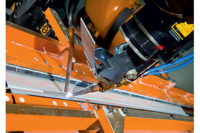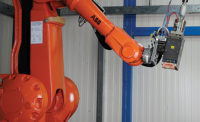The electric vehicle revolution is posing numerous assembly challenges for engineers, such as how to join dissimilar metals and how to attach large terminals onto thick cables. Ironically, a century-old technology, magnetic pulse welding (MPW), could be the answer to these problems.
A noncontact process, MPW uses electromagnetic pressure to accelerate one metal part to produce an impact against another metal part. The atomic bond created by this process is similar to the bond created by explosion welding. The technique can be used to join both similar and dissimilar metals.
MPW was originally developed in the late 1800s as a method for forming sheet metal. In the 1960s, the forming process was adapted to a process for welding the end closures of nuclear fuel rods.
A typical magnetic pulse welding system includes a power supply, which contains a bank of capacitors, a high-speed switching system and a coil. The parts to be joined are inserted into the coil, the capacitor bank is charged and the high-speed switch is activated. As current is applied to the coil, a magnetic field is created, and the outer component is collapsed over the inner component.
A significant amount of energy (5 to 200 kilojoules) is stored in the capacitors, which are charged to a high voltage (3,000 to 30,000 volts). The capacitors are then discharged through low-inductance and highly conductive bus bars into a coil that is custom-made for the assembly. The resulting current takes the form of a damped sine wave. Peak currents during this process range between tens of thousands and millions of amperes, with pulse widths measured in microseconds.
This creates an extremely intense transient magnetic field in the vicinity of the coil. The magnetic field induces eddy currents in any conductive materials nearby, in the opposite direction to the primary current. The opposing fields in the coil and workpiece result in a high repulsion force. This force drives the workpiece closest to the coil at high velocity toward the target, the stationary workpiece, resulting in a high impact between the two metals.
The impact pressure drives away surface contaminants and oxides on the parts and provides intimate contact across the joint interface, creating a solid-state bond without melting the materials. There is no heat-affected zone, and the purity of the metals, on the surface and below the surface, is preserved.
As a result, the process is particularly suitable for joining dissimilar metals, such as copper and aluminum, since little or no intermetallic compounds are created. The joint is gas-tight and stronger than the parent materials.
The magnetic properties of the workpiece materials are not relevant. The electromagnetic field is strong enough that any conductive metal will work.
The parts to be joined should be located 1 to 2 millimeters from each other, so that one can be accelerated. Despite that short distance, the part’s speed at impact can be well more than 300 meters per second.
Advantages And Limitations
MPW has numerous advantages, besides the ability to join dissimilar metals. For starters, it’s fast. The process takes 10 to 100 microseconds. The only time limitation is loading and unloading the parts and charging the capacitors. The process is suitable for mass-production.
The process does not require consumables. There’s no need for filler materials or shielding gas, and there are no electrodes to clean or replace.
It’s a safe process. It does not produce smoke or radiation, and fume extraction equipment is not required.
After welding, there are almost no residual stresses in the joint, and no corrosion development in the welding area. Zero part distortion can be achieved depending on the part materials and geometry.
On the other hand, the process has some limitations. It can be challenging to apply to welds that are not roughly circular, so the geometry of the parts may have to be changed. If the parts cannot be slid into and out of the pulse coil. a more complex multi-part coil must be designed. In addition, the coil may have to be redesigned if the materials or part dimensions change.
Brittle components can be fractured by the shock. In addition, the electromagnetic pulse can temporarily or permanently disable electrical and electronic equipment inside or near the parts.
Finally, the process is not inexpensive. For low-volume assemblies, the initial investment cost may outweigh the lower price-per-weld.
Applications
MPW requires a lap joint configuration, since the outer part must impact the inner part to create the weld.
The MPW process has numerous applications for EV assembly, such as bus bars and battery housings. It can attach heavy-duty terminals to thick cables with high compression, high strength and low resistance. The process can accommodate cables with a cross-section of up to 400 square millimeters.
Battery pouches are advantageous due to their low weight and because they can easily be stacked on top of each other. However, they are sensitive to heat input. MPW is ideal for assembling these pouches, because it works without heat input and without touching the tabs. The process can weld positive polarity aluminum tabs to negative polarity copper tabs, which might be nickel-coated or uncoated. Since it’s a cold process, the plastic parts of the bags, insulators and sealing strips do not melt. After welding, the electrical resistance in the joint is equal to the parent metal. Several welds can be made simultaneously with one pulse.
The process can even be used to weld frame assemblies, braces and sheet metal profiles for body-in-white manufacturing. Here, the ability of MPW to weld dissimilar materials, such as steel and aluminum, can benefit lightweighting efforts. Welds up to 2 meters long can be accomplished with one pulse.
Beyond the EV industry, MPW can be used to assemble torque tubes, fuel lines and pressure vessels.
ASSEMBLY ONLINE
For more information on welding wire, visit www.assemblymag.com to read these articles:
Ultrasonic Welding of Wire to Metal






